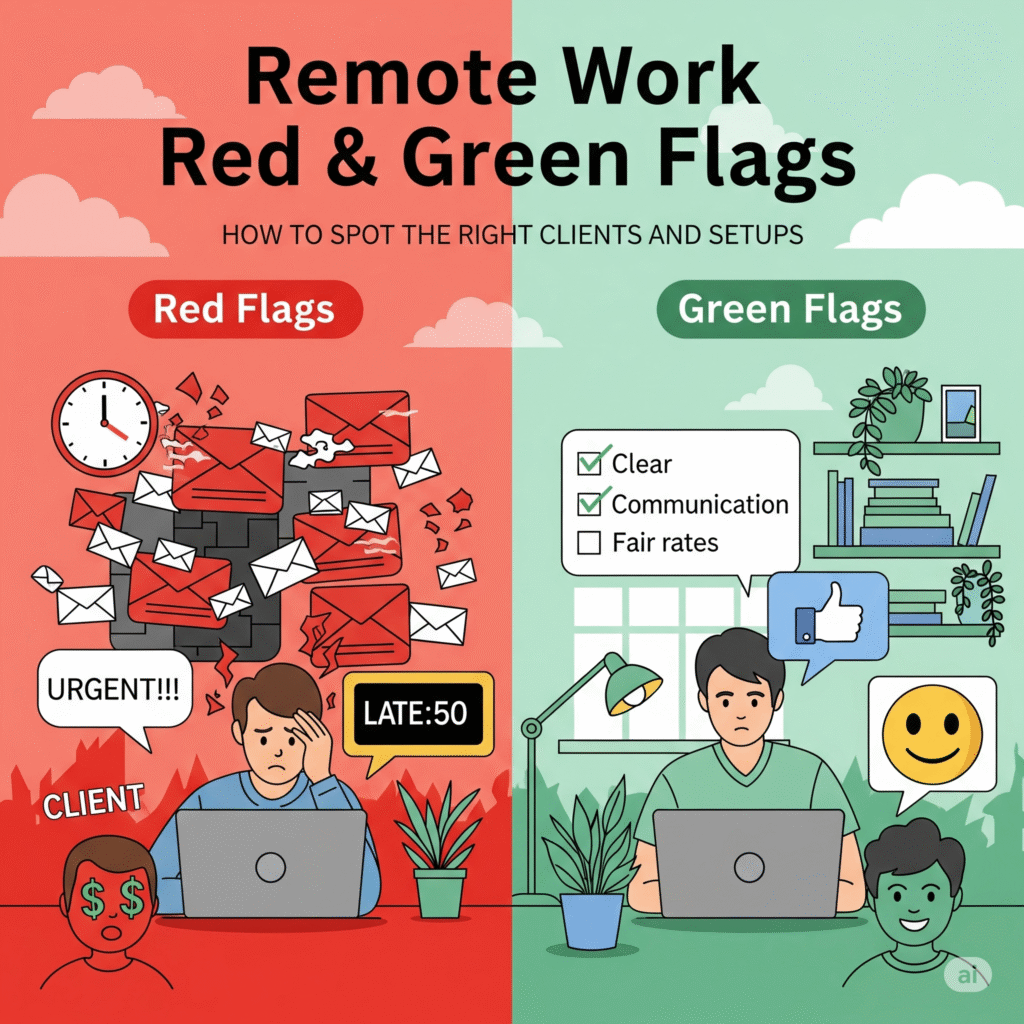
Remote work is no longer just a trend—it’s a standard. With companies and professionals worldwide embracing flexible setups, remote jobs are booming. But not every opportunity is golden. Some can be empowering green flags, while others are red flags that scream trouble. Knowing how to spot the difference can save you from stress, burnout, and wasted effort.
Understanding Remote Work Dynamics
Benefits of Remote Work
- Freedom to work from anywhere.
- Better work-life balance.
- Reduced commuting stress.
- Global opportunities for freelancers and employees alike.
Challenges in Remote Work
- Miscommunication due to time zones.
- Loneliness and lack of team bonding.
- Payment disputes in freelance setups.
- Overlapping personal and professional life.
What Are Red & Green Flags in Remote Work?
Think of them like relationship signals. Red flags are warning signs—things that should make you cautious. Green flags, on the other hand, signal a healthy and productive environment. Recognizing these signs ensures you don’t waste time with the wrong clients or companies.
Red Flags in Remote Work: Warning Signs to Watch Out For
1. Lack of Clear Communication
If you’re always guessing what the client wants, expect constant frustration.
2. Unrealistic Deadlines
Deadlines that ignore human limitations are a recipe for burnout.
3. No Written Contracts or Agreements
Verbal promises won’t protect you when payments go missing.
4. Micromanagement Tendencies
If a client constantly checks your every move, it kills productivity and trust.
5. Delayed or Missing Payments
Consistent excuses for late payments are a big red flag.
6. High Turnover Rates
If many freelancers or employees leave quickly, there’s usually a reason.
7. Vague Job Descriptions
When responsibilities aren’t clear, expect confusion and shifting expectations.
Green Flags in Remote Work: Signs of a Healthy Setup
1. Clear Communication Channels
Structured meetings, tools like Slack or Teams, and responsiveness are great signs.
2. Defined Roles and Responsibilities
You know exactly what’s expected of you—no guesswork.
3. Fair Pay and Timely Payments
Clients who pay on time are the ones worth keeping.
4. Flexible Schedules
Trusting you to manage your time signals respect.
5. Supportive Company Culture
Positive feedback, inclusivity, and recognition make remote work enjoyable.
6. Opportunities for Growth and Learning
Workshops, upskilling budgets, and mentorship show long-term investment.
7. Respect for Work-Life Balance
If clients don’t expect you online 24/7, that’s a huge green flag.
Spotting Red Flags Before Accepting a Job or Client
- Read job postings carefully—vague pay and duties often hide issues.
- Ask interview questions like: How do you handle payments? How do you communicate deadlines?
- Research the client/company on LinkedIn, Glassdoor, or freelance platforms.
Green Flags During Onboarding
- Contracts and NDAs are shared upfront.
- They provide access to tools like Trello, Slack, or Notion.
- You feel guided rather than thrown into chaos.
How to Handle Red Flags Once You Notice Them
- Communicate concerns politely but firmly.
- Set boundaries and suggest solutions.
- If things don’t improve, walk away before more damage is done.
Balancing Trust and Caution in Remote Work
Not every unusual thing is a red flag—sometimes it’s just a different style. Stay cautious, but don’t become paranoid. Building trust online takes time, but it’s possible.
Tools That Help Identify Red & Green Flags
- Upwork/Glassdoor reviews for reputation checks.
- Trello/Asana/Slack for clear workflows.
- Freelancer forums for real feedback.
How Freelancers Can Protect Themselves
- Always use contracts.
- Request milestone-based payments.
- Use secure payment systems like Payoneer, PayPal, or Escrow.
How Companies Can Show Green Flags to Attract Talent
- Share clear, honest job descriptions.
- Build a transparent reputation on LinkedIn.
- Pay fairly and on time.
- Provide career growth opportunities.
Case Studies: Real-Life Examples
Bad Client Scenario
A freelancer joined a project without a contract. The client kept changing deadlines and eventually disappeared without paying.
Positive Experience
Another freelancer worked with a client who provided clear briefs, timely payments, and growth opportunities. That relationship lasted years.
Practical Checklist for Evaluating Remote Work Opportunities
- Is there a contract? ✅
- Is pay clear and fair? ✅
- Are responsibilities well-defined? ✅
- Does the client respect boundaries? ✅
- Is communication smooth? ✅
Conclusion
Remote work can be incredibly rewarding if you know how to filter out the bad setups from the good ones. By watching out for red flags and embracing green ones, you set yourself up for not just success—but peace of mind.
FAQs
1. What’s the biggest red flag in remote work?
Consistently delayed payments—money issues usually signal bigger problems.
2. How can I test if a client is trustworthy?
Check reviews, ask for contracts, and start with a small project before committing long-term.
3. Are all strict deadlines a red flag?
No—deadlines are normal. But if they’re always unrealistic, that’s a problem.
4. How do companies show they’re good remote employers?
By being transparent, fair with payments, and respecting work-life balance.
5. Can red flag clients turn into green flag clients?
Sometimes. If they’re open to feedback and improve processes, the relationship can change.
Your remote career deserves more than trial and error. That’s why we’ve built a digital guide to help you spot red and green flags, land reliable clients, and grow with confidence. And if you’re ready to take things further, HIB Recruitment Services is here to support you—whether you’re a job seeker looking for the right role or a business seeking top talent. Let’s make your next move the right one—start here
Leave a Reply